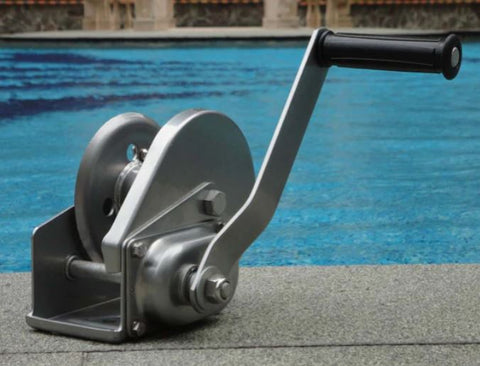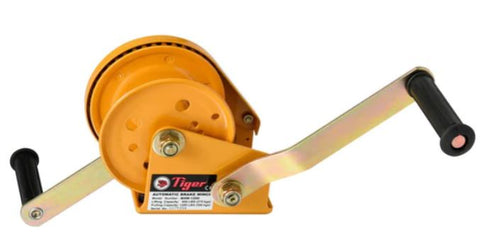Choosing a Hand Winch
In the world of manual lifting and pulling, a hand winch is an invaluable tool. Whether you're a seasoned outdoors enthusiast, an avid DIYer, or simply in need of a reliable winching solution, choosing the right hand winch can make all the difference. In this comprehensive guide, we will walk you through everything you need to know in order to make an informed decision when it comes to selecting the perfect hand winch for your needs.

Understanding the Basics of a Hand Winch
Before diving into the factors you should consider when choosing a hand winch, let's start with the basics. What exactly is a hand winch? Put simply, it is a mechanical device used to lift or pull heavy loads by utilizing manual force. Though the mechanisms may vary, hand winches typically consist of several key components that work together to get the job done.
What is a Hand Winch?
A hand winch is a portable and versatile device that is manually operated to lift or pull heavy objects. It is commonly used in various applications, including but not limited to, off-roading, boating, and construction. The main advantage of a hand winch is its ability to provide controlled lifting or pulling power without the need for electricity or complex machinery.
Key Components of a Hand Winch
A typical hand winch comprises essential components such as a drum or spool, a gear mechanism, a handle or crank, and a cable or strap. The drum or spool is where the cable or strap is wound around. The gear mechanism translates the force applied by the operator into the desired lifting or pulling action. The handle or crank allows for manual operation, while the cable or strap is the means by which the load is secured and moved.
Additionally, some hand winches may include features like a brake system to prevent the load from slipping back, and a ratchet to ensure the load stays in place once lifted. These safety features are crucial in ensuring the smooth and secure operation of the hand winch, especially when dealing with heavy loads or working in challenging environments.
Choosing the Right Hand Winch
When selecting a hand winch for your specific needs, it's important to consider factors such as the weight capacity, the length and material of the cable or strap, the gear ratio for lifting efficiency, and the overall durability of the device. Understanding how these factors interplay with your intended usage will help you make an informed decision and ensure that you have the right tool for the job.
Factors to Consider When Choosing a Hand Winch
Now that you have a basic understanding of what a hand winch is, let's delve into the factors you should keep in mind when selecting the right one for your specific needs.
When it comes to choosing a hand winch, there are a few additional factors that can greatly impact its functionality and suitability for your intended applications. Let's explore these factors in more detail.
Load Capacity
One of the first things to consider when choosing a hand winch is its load capacity. This refers to the maximum weight that the winch is capable of safely lifting or pulling. It is crucial to assess your intended applications and determine the maximum weight you will likely encounter. Selecting a winch with a suitable load capacity ensures that it can handle the demands placed upon it without compromising safety or performance. Furthermore, it's important to consider the dynamic load capacity of the winch. This refers to the maximum weight the winch can handle while in motion. Taking into account the weight of the load and any potential inclines or obstacles that may affect the winching process is essential for a successful operation.
Cable Length and Material
Another important factor to consider is the length and material of the winch's cable or strap. The length of the cable or strap determines the maximum distance over which the winch can be operated effectively. It is essential to choose a length that accommodates your specific requirements, whether it be for pulling vehicles out of mud or lifting heavy equipment onto a truck bed.
Additionally, considering the material of the cable or strap is crucial as it impacts durability and strength. Steel cables are known for their strength and resistance to abrasion, making them suitable for heavy-duty applications. On the other hand, synthetic straps are lightweight and flexible, making them ideal for situations where weight and manoeuvrability are key factors.

Gear Ratio
The gear ratio is a key factor that affects the mechanical advantage of a hand winch. It determines the speed at which the winch operates and the amount of force it can exert. Understanding the gear ratio is vital to ensure that the winch is capable of delivering the necessary pulling or lifting power required for your intended tasks.
It's worth noting that different gear ratios offer different trade-offs. A winch with a higher gear ratio will provide faster operation but may sacrifice some pulling power. Conversely, a winch with a lower gear ratio will offer more pulling power but at a slower speed. It is important to strike a balance between speed and force, depending on your specific needs.
Winch Type
Hand winches are available in various types, each suited to different applications. Some common types include two-way ratchet, brake winches, and worm gear winches.
Two-way ratchet winches are versatile and can be operated in both directions, useful for applications such as boat trailer loading. Brake winches, on the other hand, are designed for heavy-duty applications and feature a braking mechanism that holds the load securely, providing added safety and stability. Lastly, worm gear winches provide excellent control and are often used in situations where precise winching is required, such as in construction or landscaping projects.
Choosing the right winch type ensures optimal performance and reliability, so it's important to carefully consider your specific needs and the demands of your intended applications.
The Importance of Hand Winch Safety
While hand winches offer great convenience and versatility, it is crucial to prioritize safety when operating them. Neglecting safety precautions can lead to accidents and injuries. Here are some guidelines to keep in mind:
Safe Operation Guidelines
Always read and follow the manufacturer's instructions for your specific hand winch model. Inspect the winch regularly for any signs of damage or wear. Use appropriate personal protective equipment, such as gloves, when handling the winch. Ensure that the load is properly secured and distribute the weight evenly. Avoid exceeding the winch's load capacity. Be aware of your surroundings and communicate effectively with others involved in the operation. Finally, remember to operate the winch slowly and steadily, maintaining control throughout the process. Our Tiger Hand Winch Safety Awareness Course provides the necessary knowledge to operate efficiently and, most importantly, safely.
Maintenance and Inspection Tips
Regular maintenance and inspection of your hand winch are essential for optimal performance and longevity. Check the cable or strap for any signs of fraying, kinks, or other damage. Lubricate the moving parts as recommended by the manufacturer. Keep the winch clean and free from debris. Store it properly when not in use to prevent exposure to the elements. By taking care of your hand winch, you can ensure reliable operation and extend its lifespan.
Making Your Final Decision
After considering all the important factors and understanding the safety guidelines, it's time to make your final decision.
Assessing Your Needs
Take a moment to revisit your specific needs and requirements. Consider the types of loads you'll be handling, the frequency of use, and any unique challenges you may encounter. By evaluating your needs, you can narrow down the range of options and select a hand winch that perfectly aligns with your specific situation.

Weighing Cost Against Quality
While budget is always a consideration, it's essential not to sacrifice quality for a lower price. Investing in a high-quality hand winch from a trusted brand may cost more initially but can save you money and headaches in the long run. Consider the value and longevity of the winch as well as the warranty and customer support offered by the manufacturer. Striking the right balance between cost and quality will ensure your satisfaction with your hand winch purchase.
Considering Long-Term Durability
Lastly, consider the durability of the hand winch you are considering. Look for features such as corrosion resistance, reliable construction, and quality materials. A durable winch will not only withstand the demands of your tasks but also provide years of reliable service. Take the time to read reviews, compare specifications, and choose a winch that is built to last. With this ultimate guide to choosing a hand winch, you are now equipped with the knowledge and understanding to make an informed decision. Remember to consider the basics, understand the key components, evaluate the relevant factors, prioritize safety, compare different brands, and ultimately choose a winch that meets your needs in terms of cost, quality, and durability.

